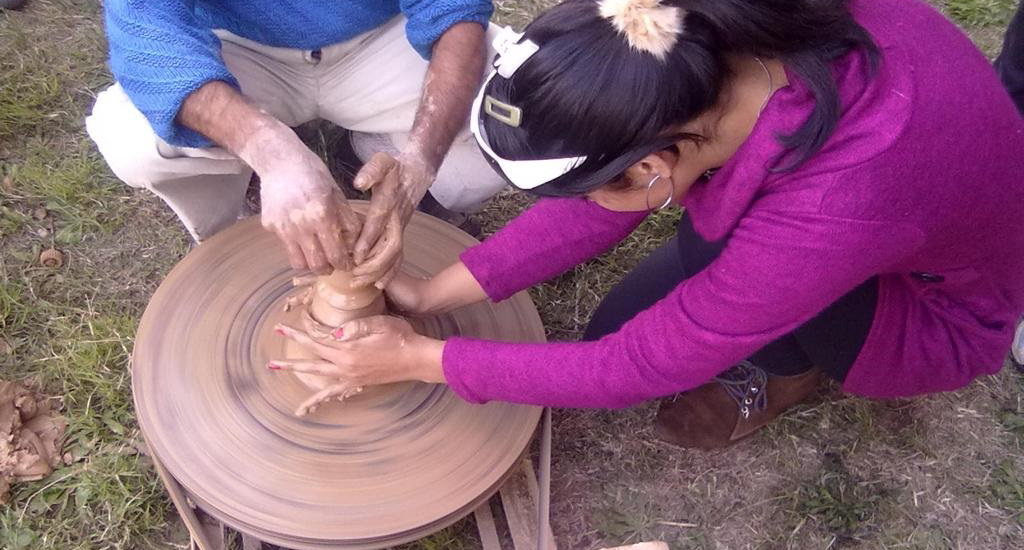
A young woman engineer spurs hope for pottery in Kashmir
Traditional potters struggling to survive are confident of better business again after a young woman who found hope through pottery is bringing it back into the limelight.

Traditional potters struggling to survive are confident of better business again after a young woman who found hope through pottery is bringing it back into the limelight.
With so much talk about depression – especially among the young – it might be hard to imagine that the ancient art of moulding clay can help defeat mental illness.
But, yes it can.
So says Saima Shafi Mir, popularly known as “Kralkoor,” meaning potter girl in local parlance.
Seated at her potter’s wheel, Mir deftly moulds clay as the wheel spins. When she stops the wheel, it is a beautiful flower vase that she holds between her careful fingers.
The art of pottery not only helped her beat depression, it has made her an icon of modern-day pottery in Kashmir.
Personal problems in her life had pushed Mir into severe depression. Psychiatric sessions and consuming psychotropic drugs and anti-depressants made her lethargic.
“I became listless and lazy, not to say bored too,” recalled Mir.
She looked for activities to overcome her overwhelming ennui. That was when a flower vase at home caught her attention.

“My childhood fascination for clay artefacts and my desperation pushed me towards pottery,” she said.
Mir pointed out that Sufi saints, like Socha Kral, have also been associated with the art of pottery.
“I’ve heard people say that pottery connects your soul to the earth. But I understood that only after I embraced the art myself,” she said.
Mir learned both terracotta and modern pottery from a studio in Bengaluru. But back in the valley she found the artform had few takers – especially among women.
Pottery had lost its sheen for most Kashmiris. (ALSO READ: Ferocious river threatens potters’ livelihood)
Low returns, never mind tough social issues, had pushed the once-glorious craft to an inferior status.

“There’s a sort of a social taboo attached with the art. We were reluctant to admit that we were potters,” said Ghulam Ahmad Kumar of Budgam. “Our children had also lost interest in the traditional craft.”
While the younger generation, even those from the potter families, lost interest in clay, Mir was becoming passionate about it.
As soon as she would finish her day job as an engineer, she was at the potter’s wheel – a habit she maintains.
Mir, who calls herself “Kralkoor” on social media, has nearly 42,000 followers on Instagram. She is the first woman in Kashmir to project herself as a potter, especially one who spins the potter’s wheel.
For Kashmir’s age-old craft always had a gender bias.
“Even in families that still practice pottery, women might do the other work. But they never turn the wheel,” said Mir.

But the young engineer’s social media posts – showing her soiled hands moulding clay – has had a positive impact.
“Our children now try their hands at the wheel. They proudly showcase their art with friends and on social media,” said Ahmad Kumar.
Mir agrees that her work has instilled confidence among the youth – especially girls.
“I tell them that if I, a well-settled woman engineer, can embrace the art, they can too,” she told Village Square.
Shaheena, a young girl from a potter family in Budgam, used to practise at the wheel secretly when no one was home.

“I help my father in preparing the clay. But the wheel was a no-no. My parents used to say ‘who will marry a girl who sits at the wheel’,” said Shaheena. “After seeing Kralkoor’s work winning praises, my parents allow me to spin the wheel.”
Mir set up her own studio in Srinagar – equipped with modern equipment, like an electric wheel and kiln.
“I set it up only for my work. But many people asked me to teach them,” she said.
She has 15 students now.
“For many it’s a hobby, but some want to make it a career,” she said.
“There are a few girls passionate about it. I’d say motivating girls to take up pottery is my biggest achievement.”
Recognising Mir’s work, the Directorate of Handicrafts & Handloom Kashmir is projecting her as the potter icon to promote pottery.

Last year the department organised many meetings for potters, where Mir spoke.
The department has initiated a survey to find the exact number of potters practising the traditional craft and promise to support the once-dying craft.
“We want to introduce welfare schemes for the potter community. We want to preserve, revive and modernise the traditional art by getting them modern equipment,” said Shariq Iqbal Lone, additional director, Department of Handicrafts, Kashmir.
“Recently we opened the valley’s first glazed pottery centre on the outskirts of Srinagar, where we train artisans,” Lone added.
While the young engineer is becoming the face of modern terracotta and glazed pottery, she is also an inspiration to many of the traditional potters, grateful for the revival she is inspiring.
Nasir Yousufi is an independent journalist based in Srinagar.